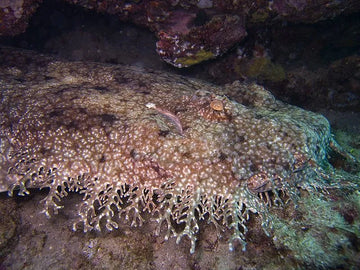Wobbegong is the accepted common name for the 12 species of carpet sharks in the family Orectolobidae. These sharks are found in the shallow waters of the Pacific and Indian Oceans, mainly around Australia, Indonesia and the Philippines, with the exception of one species, Orectolobus japonicus, which inhabits the waters off southern Japan.
Did you know that we have a collection of shark T-shirts and hoodies? Super original and of very good quality.
The word "wobbegong" is believed to derive from an Australian Aboriginal word meaning "rough beard", in reference to the filaments that grow around the mouth of the Western Pacific carpet shark, which simulate algae and are an element that facilitates its camouflage, but also act as sensory receptors.
Wobbegongs are bottom dwelling sharks that spend much of their time resting on sandy or rocky bottoms down to depths of 40 meters. Most species have a maximum length of 1.25 meters and the largest, the Spotted Wobbegong (Maculatus Orectolobus), can reach about 3 meters.
Wobbegong shark in Raja Ampat
The most outstanding characteristic of Carpet Sharks is their excellent camouflage due to the symmetrical pattern of dark markings on their skin. These sharks go completely unnoticed on reefs, hiding between rocks or on table corals to catch smaller fish that swim nearby. Wobbegongs feed at night and their diet includes fish, octopus, crabs or lobsters. It is also known as a "shark hunter" because it also eats small sharks such as dogfish or bamboo sharks.
Wobbegongs are generally not dangerous to divers unless provoked, accidentally touched or threatened by blocking their escape route. Their mouth is full of small, sharp teeth that can easily penetrate a wetsuit, and once bitten, they are difficult to dislodge from their jaws.
Carpet sharks, unlike other sharks, are not endangered. Their main natural predators are larger reef sharks. In Australia, their meat is used for fish and chips and their colorful skin for clothing. Smaller species of carpet sharks are marketed for aquariums, although they are not very popular due to their low activity and large size.





















